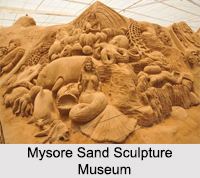 Sand sculpture is reminiscent of any Indian sculptures and can be of multiple shapes, sizes and forms. This form of art was native to Odisha but has now spread its roots to the whole of India. In this nation, people are acquainted with various forms of sculptures like stone, wood, bronze and marble carved sculptures. But the form of sand sculpting is usually preceded by stone carving. Carving on sand is much easier and quicker than on a rigid stone. The sculptures are temporary and can be washed or blown away. Often times, coloured sand is also used to create these sculptures. The goal of making sand sculptures is that to create those objects which appear to be an artistic example.
Sand sculpture is reminiscent of any Indian sculptures and can be of multiple shapes, sizes and forms. This form of art was native to Odisha but has now spread its roots to the whole of India. In this nation, people are acquainted with various forms of sculptures like stone, wood, bronze and marble carved sculptures. But the form of sand sculpting is usually preceded by stone carving. Carving on sand is much easier and quicker than on a rigid stone. The sculptures are temporary and can be washed or blown away. Often times, coloured sand is also used to create these sculptures. The goal of making sand sculptures is that to create those objects which appear to be an artistic example.
Museums in India on Sand Sculptures
In India, there are varied types of museums, starting from fine arts, archaeology, history, botanical, technology to science. But there is only one museum on sand sculptures. Located in Mysore, close to the Chamundi Hills is the Mysore Sand Sculpture Museum. Spread over an area of 13,500 sq ft, the museum was created by MN Gowri, who is said to be the only female sand sculptor artist in India. The museum displays around 150 sculptures of sand in 16 different themes, ranging from Mysore"s heritage, wildlife and culture, along-with instances from different religious epics and fairy tales and stories.
The sculptures are created solely with sand, water and a small amount of glue. At the entrance of the museum, there is a 15 feet high sand sculpted statue of Lord Ganesha. Other sand sculptures at the museum are of Goddess Chamundeshwari, erstwhile Mysore King Srikanta Datta NarasimhaRaja Wadiyar who is shown seated on his throne during a Dasara festival, Lord Krishna and Arjuna on a horse-drawn chariot. Along-with the Laughing Buddha, a Christmas tree and Santa Claus, Disneyland, ancient Egypt, Zodiac Wheel, and instances from Arabian nights, Tom & Jerry cartoon, etc.
Sand Sculptors of India
The concept of sand-art is still at its nascent state and emerging in India. In the last couple of years, sand-art has garnered a bit of popularity due to the impressive works of the sculptors. Listed below are the names of those famous sand sculptors whose works have made the country proud.
 Sudarshan Pattnaik: Known to be the inventor of sand art in India, Sudarshan Pattnaik is one of the most famous sand artists, not only in Odisha but all over the world. He has designed hundreds of sand sculptures and was even awarded the Padma Shri in the year 2014. He uses his art to spread social awareness among the people. His sculptures include environmental crisis, famous festivals, national integrity and religious intolerance. Sudarshan has also established the "Golden Sand Art Institute", now renamed as Sudarshan Sand Art Institute; it is the first of its kind in India.
Sudarshan Pattnaik: Known to be the inventor of sand art in India, Sudarshan Pattnaik is one of the most famous sand artists, not only in Odisha but all over the world. He has designed hundreds of sand sculptures and was even awarded the Padma Shri in the year 2014. He uses his art to spread social awareness among the people. His sculptures include environmental crisis, famous festivals, national integrity and religious intolerance. Sudarshan has also established the "Golden Sand Art Institute", now renamed as Sudarshan Sand Art Institute; it is the first of its kind in India.
Nitish Bharti: He is a world-famous Indian sand animation artist who demonstrates his unique method of visual storytelling using sand and a light table. His animated short film titled Save Mother Earth was also nominated at Cannes for the Best Short Film category in 2015. Nitish was amongst the top three finalists of the reality show competition India`s Got Talent 2012 and semi-finalist at Asia Got Talent 2015.
Rahul Arya: He is an internationally acclaimed sand artist; he has been on over 7 TV shows, 4 films and has received over 24 prestigious awards and a million views online. In 2016, South Asian Games, Guwahati, Rahul"s sand art inaugurated the event, and it was presented in front of Indian Prime Minister, Narendra Modi. He is not just a sand artist, but also an entrepreneur who founded a film production house, Flying Rock Studio.
Manas Kumar Sahoo: He was one of the participants in India"s Got Talent Khoj-2, which gave him the platform and the opportunity to come to the limelight. He participated in various International events; among them was "Dubai International Talent Hunt- 2011'. He was invited by The King of Dubai to demonstrate his skills in sand animation. He was also the recipient of the Rashtriya Ratna Award and the Bharat Excellence Award in 2013.
Kaushik: He is the first Indian sand artist to release a sand animation film which was based on the legendary epic Ramayana. Bengali folk art and traditional forms are the base of his work He meticulously blends European touches to make it more contemporary and international. He develops some superb motivational, mythological, and social stories. He has done notable work nationally as well as internationally.
Sand sculpture is a form of art that is now being recognized more by the public with its growing popularity nationally and internationally.



















